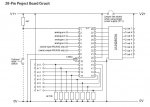holmedwa04
Member
Dear All
I am using a PICAXE 28X1 and like to be able to call different sub routines depending on what is on four out of the eight digital inputs.
I have a 4 bit binary number 0 - 15 (decimal equivilent) that I would like to feed into 4 of the digital inputs of the PICAXE. I would then like to use the different input "codes" to start different sub flows.
Any help would greatly appreciated.
I am using a PICAXE 28X1 and like to be able to call different sub routines depending on what is on four out of the eight digital inputs.
I have a 4 bit binary number 0 - 15 (decimal equivilent) that I would like to feed into 4 of the digital inputs of the PICAXE. I would then like to use the different input "codes" to start different sub flows.
Any help would greatly appreciated.



